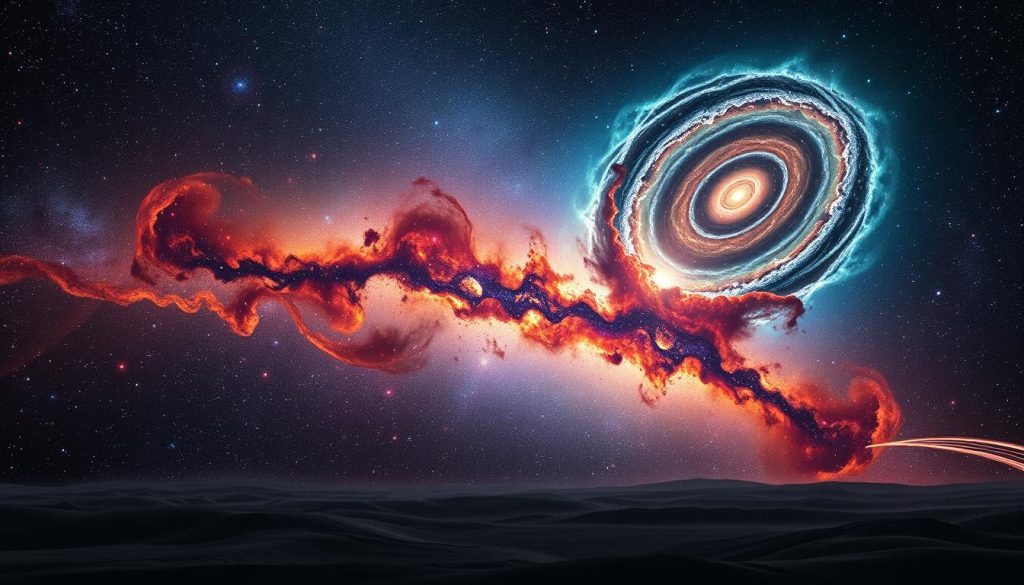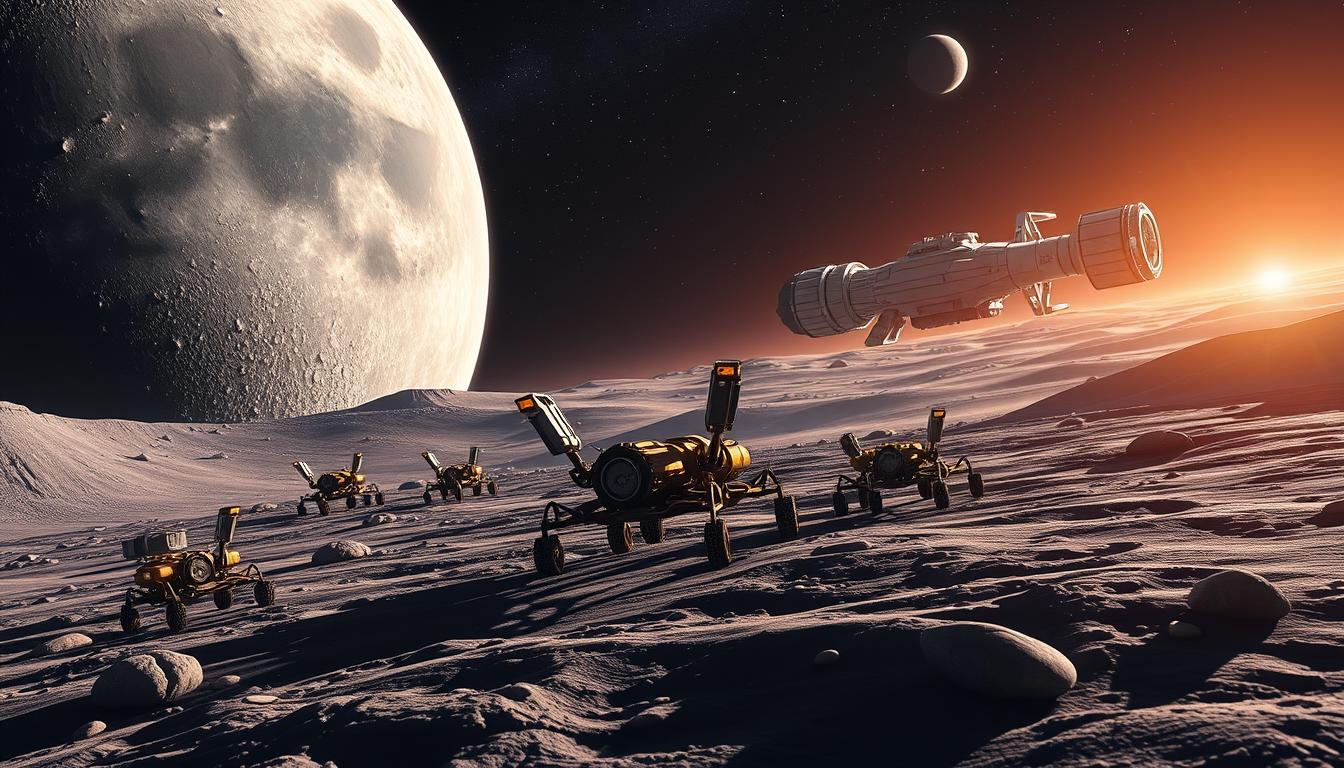The universe might be older than we thought, says NASA’s James Webb Space Telescope (JWST). This news shakes up what we know about the universe’s start and growth. The JWST has made big discoveries that change how we see the stars and planets.
With each new find, the JWST is rewriting the story of our universe. It makes scientists think again about how old the universe is.
Key Takeaways
- James Webb Space Telescope provides crucial insights challenging previous estimates of the universe’s age.
- New evidence suggests the Moon may have formed earlier than previously thought, impacting our understanding of planetary history.
- Examination of ‘impossible early galaxies’ raises questions about standard cosmological models.
- The evolution of cosmic theories continues to adapt in light of fresh findings.
- Scientific consensus around the age of the universe is evolving, with new models proposing increased timelines.
Introduction to the James Webb Space Telescope’s Discoveries
The James Webb Space Telescope was launched in December 2021. It’s a big step forward in exploring the universe. It uses infrared astronomy to see things we couldn’t before.
Scientists are making new discoveries that change what we thought we knew. These discoveries are from the James Webb Space Telescope’s cosmic observations.
It has found big, early galaxies that surprise us. These galaxies are bigger than we thought they should be. This makes us think our universe might be older than we thought.
This idea comes from a new model by Gupta. It says our universe is older. This would give galaxies enough time to grow big.
This new idea makes us think about things like “tired light.” It also makes us wonder if things change over time. The ΛCDM model works well for many things, but Gupta’s model has its own problems.
The James Webb Space Telescope shows galaxies that look young and bright. This is hard for Gupta’s theories to explain.
Researchers found many big galaxies with the James Webb Space Telescope. They think black holes might make these galaxies look big. This helps us understand how stars formed in the early universe.
This discovery makes us want to learn more. We want to know how much light comes from stars and how much from gas around black holes.
The James Webb Space Telescope is changing how we see the universe. It’s making us think differently about how the universe evolved.
The Age of the Universe: A Shifting Paradigm
The age of the universe has changed a lot over time. This change came from new space observations and better models of the cosmos. For a long time, people thought the universe was about 13.8 billion years old. This idea came from early space missions like the Hubble Space Telescope.
Current Understanding of the Universe’s Age
New discoveries from the JWST challenge old ideas. Today, most scientists still think the universe is about 13.8 billion years old. But, some new studies say it might be as old as 26.7 billion years. This makes scientists debate about the universe’s true age.
Historical Perspectives and Previous Estimates
Before the Hubble’s work, guesses about the universe’s age were all over the place. They ranged from 7 billion to over 20 billion years. Old ideas like the “tired light” theory tried to explain the universe but didn’t match up with what we see. This shows how our views on the universe’s age have changed with new tech and knowledge. Even though we think the universe is young, new findings make us realize there’s still a lot to learn.

| Source | Estimated Age (Billion Years) |
|---|---|
| Hubble Space Telescope | 13.8 |
| Planck Mission (2013) | 13.82 |
| Wilkinson Microwave Anisotropy Probe (2012) | 13.772 |
| Atacama Cosmology Telescope | 13.77 |
| Recent Studies | 26.7 |
| Tired Light Theory | 28 |
New Evidence Suggests the Universe is Much Older Than We Thought
The quest to understand the cosmic age has taken a fascinating turn. New evidence shows the universe might be much older than we thought. The James Webb Telescope discoveries have brought new insights into the timeline of cosmic events.
For decades, scientists believed the universe was about 13.7 billion years old. But now, research suggests it could be as old as 26.7 billion years. This comes from studying ancient stars and galaxies that seem too old to exist.
For example, metal-poor stars are dated between 13.3 billion and 16.0 billion years. New methods for assessing globular clusters suggest ages from 14.7 to 21.6 billion years. These ages suggest the universe’s timeline needs a big update.
NASA’s James Webb Space Telescope has found anomalies that suggest massive galaxies existed earlier than thought. These discoveries make scientists rethink how the universe formed and evolved. They are exploring these findings, which could change our understanding of the universe.
Challenging the Big Bang Theory
The James Webb Space Telescope (JWST) has made big discoveries. It found ‘impossible early galaxies’ that question our Big Bang theory. These galaxies have complex structures that shouldn’t exist so early, based on our current models.
The Role of ‘Impossible Early Galaxies’
The JWST found galaxies that are older than we thought. They could be 26.7 billion years old, not 13.8 billion. This makes us think about the universe’s history in a new way.
Impact on Existing Cosmological Models
These findings change how we see the universe. They make us question our old ideas about how it evolved. We might need new physics to understand these galaxies.
| Key Observations | Current Understanding | Implications |
|---|---|---|
| Existence of early galaxies | Evolution should not occur so quickly post-Big Bang | Necessitates reevaluation of Big Bang theory |
| Age estimates | Traditional model: ~13.8 billion years | New model: ~26.7 billion years |
| Redshift behavior | Standard theory linked to universe’s expansion | Possible new physics to explain anomalies |
| Hubble constant discrepancies | Long-standing consistency issues | May support Tired Light theory |
Understanding Redshift and Its Implications
Redshift is a key phenomenon that tells us a lot about the universe’s growth. It shows how light from far-off stars moves towards the red end. This helps us learn about how fast the universe is growing.
The James Webb Space Telescope (JWST) is very important in this. It helps us see the early universe, when the first galaxies started to form.
Cosmic Dawn and Early Galaxies
The JWST has found early galaxies that are really big. They formed quickly after the Big Bang. This changes what we thought about how galaxies grow.
These big galaxies show us that the universe might be growing faster than we thought. They challenge old ideas about how galaxies form.
The Doppler Effect and the Expanding Universe
The Doppler effect is important in astronomy. It shows how light changes when objects move away. This is key to understanding the universe’s growth.
When galaxies move away, their light turns red. This tells us they are moving away from us. It helps scientists measure the universe’s growth.
Recent JWST findings show that some galaxies look old but are actually young. They look big and mature but are really young. This is because of how they move and grow.
Scientists are still learning about the universe. They are studying redshift and the Doppler effect. This helps us understand the universe better.
| Concepts | Description |
|---|---|
| Redshift | A phenomenon where light from distant objects shifts to the red end of the spectrum, indicating their movement away from Earth. |
| Cosmic Dawn | An early period after the Big Bang when the first galaxies began forming, crucial for understanding the evolution of the universe. |
| Doppler Effect | The observed change in frequency or wavelength of light from an object moving relative to an observer, explaining the redshift in light from distant galaxies. |
| Universe Expansion | The ongoing increase in the distance between galaxies over time, as evidenced by redshift measurements. |
Conclusion
The James Webb Space Telescope has changed how we see the universe. It found that the universe might be 26.7 billion years old. This is more than twice the old age of 13.8 billion years.
This new idea challenges old views in cosmology. It makes scientists think about the future of understanding the universe. They want to mix these new findings with old theories.
Dark matter and dark energy play big roles in the universe’s growth. Early galaxies were very massive and mature. This makes us question how they formed.
Looking at old ideas like tired light shows how science keeps changing. More research is needed to solve mysteries of dark matter and the universe’s growth.
The James Webb Space Telescope’s discoveries shake up old ideas. They also make us want to learn more. Scientists are excited to explore and find new answers about the universe.


